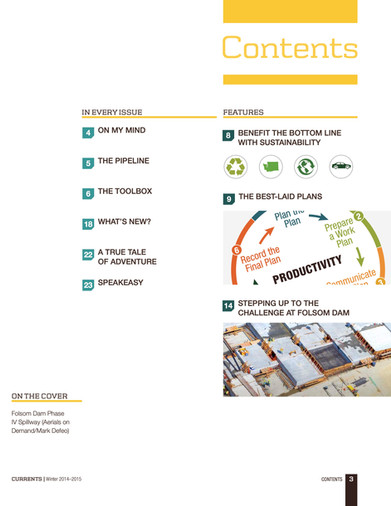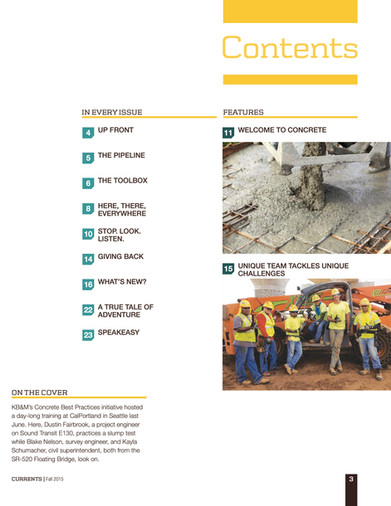Currents Magazine
The makeover of a dated employee magazine resulted in skyrocketing reviews and a 100% ROI

For more than 75 years Kiewit Bridge & Marine, the technical bridge division of a global construction company, had published an employee magazine. After so many decades, the magazine had sentimental value, but wasn’t offering return on investment. Staff didn't find it useful to their jobs, and it was visually dated and cumbersome to read. Leadership were considering eliminating it altogether.
Project Services
Assessment
Branding
Strategic messaging
Employee communications
Writer & editor
Ghostwriter
Managing editor
Assign & edit
writers' and graphics' work
Topic development & story creation
Markets
Heavy civil construction
Infrastructure
Employee communications
Fortune 500
Magazine publishing
Approach
When a long-time staffer retired, I took on the new job of managing editor. My first task was saving the magazine — and convincing leadership it was worth doing. I proposed a complete re-vamp to revise the content, design, and approach.
I led the marketing group’s writers and graphic designers—none of whom had publishing experience—to take surveys, hold focus groups, brainstorm ideas, create a relevant brand, and develop a new concept.
We built a mock-up and pitched an entirely new magazine with practical content that would help staff do their jobs better, involve readers by soliciting content from the field, and boost engagement by connecting the highly mobile workforce. We were given approval for one year.
My ongoing work included:
topic development & story creation
managing the editorial calendar
managing the publishing schedule
assigning and editing writers' work (both professional writer and staff contributors)
approving drafts
ghostwriting articles and the president's letter
Results
At the end of the year, after just four issues, we re-surveyed staff:
more than 80% of staff wanted the magazine published more often
every question improved 20 to 35 percentage points compared to the old version
questions about employee engagement (a driver in retention) improved as much as 10%
opinions on layout and design skyrocketed 37%.
writing had a 26-point increase, despite using many field staff as authors rather than writers.
Content in shorter, consumable bites made the magazine more accessible and dramatically increased readership. The variety of writers also benefited the magazine by bringing in a greater range of voices.
The magazine now paid for itself with a complete return on investment:
the practical content related to skills and on-the-job tools led directly to cost savings
improved employee engagement bolstered retention
the modern, vibrant magazine supported competitive recruiting
















